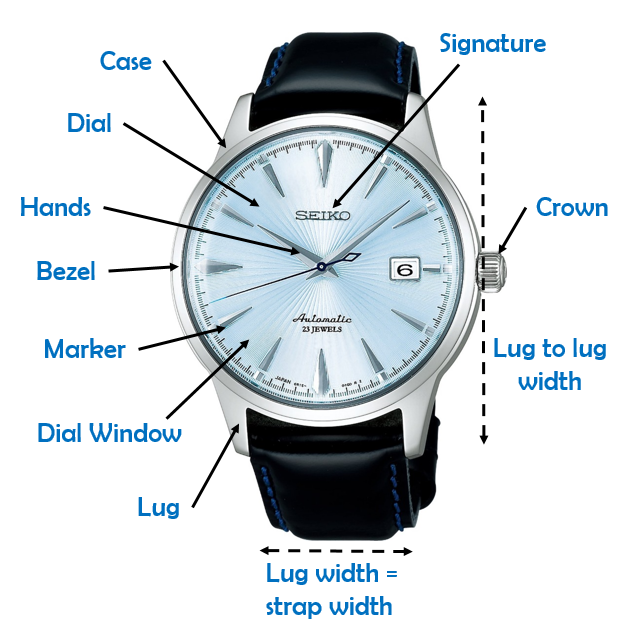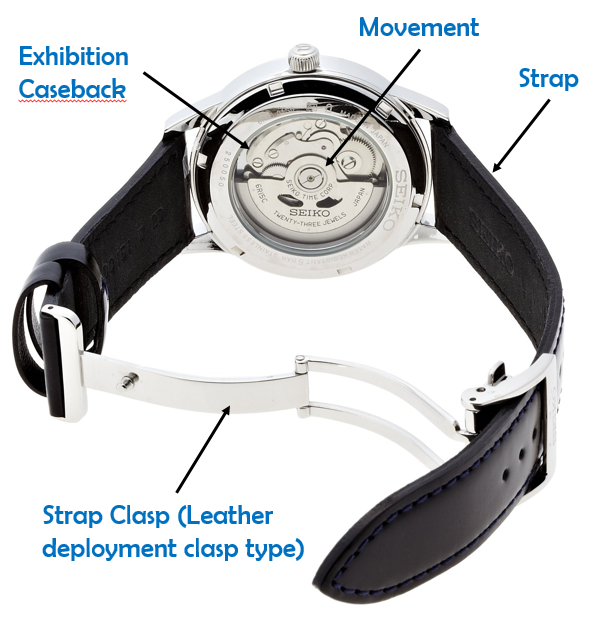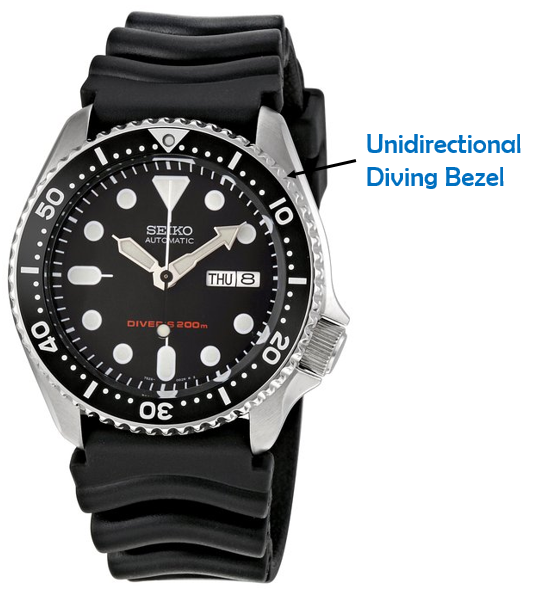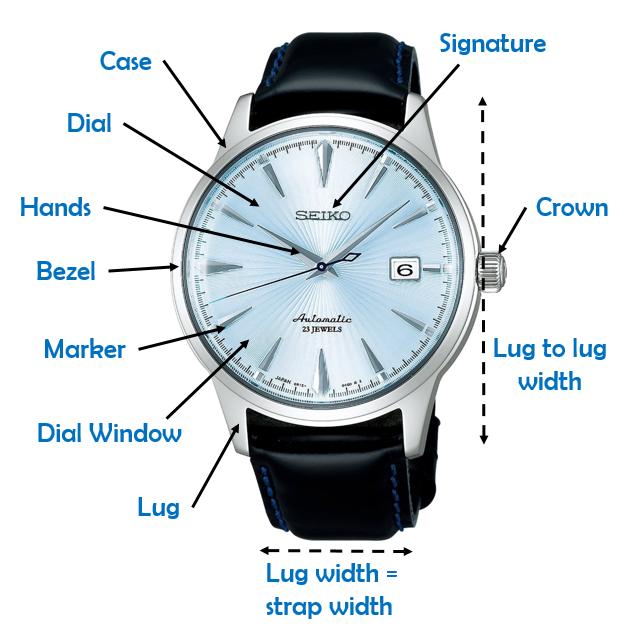Automatic watch anatomy is quite hard to understand for those new to it. In this article, I will lay down the basic information of the automatic watch anatomy. The watch diagram below will show you the parts of a watch as well as its name.

Front view of the Seiko SARB065 Cocktail Time, a dress watch with guilloche sunburst dial design. It is a normal watch with just a date function.

Back view of the Seiko SARB065 Cocktail Time. Notice the exhibition caseback that showcase the internal automatic movement inside. This watch also uses the leather deployment clasp for long lasting leather strap life.

Bulova 96A135 with 2 subdials: running seconds hand at 5 o’clock position and 24-hour hand at 9 o’clock. It also has an aperture to showcase its movement inside. On of the movement’s wheels can be seen from the aperture. Notice also the red jewel of the wheel at the center.

Seiko SKX007 is a classic diving watch. Can be seen in this picture is the unidirectional diving bezel for diver’s usage to track time underwater. The markers are big circles to allow for maximum luminescent material for the brightest lume underwater.

Victorinox Infantry Vintage is a traditional military watch with telemeter scale. It also has chronograph function that is operated by it’s pushers at the right side of the watch.
Automatic Watch Anatomy Parts:
Aperture: An opening on the watch’s dial. It can be used to show the internal automatic movement (which is really cool btw, you can see the Bulova 96A135 dial above with its aperture that shows one of its wheel.)
Bezel: The edge of the case with the dial window. Some of the more popular usage/types of bezel are:
1) Unidirectional bezel with minute markers (diving bezel): This bezel is usually for diving watches. The minute markers is used to keep track of time underwater. Simply set the “00 Minute” to the minute hand when starting the dive. As you dive, the minute hand will move and you can see how many minutes has elapsed during diving.
The unidirectional is keeping the bezel to be rotated only anticlockwise. It can’t be rotated clockwise as this will cause problems for divers to keep their diving time in check. You can see the Seiko SKX007 above for an example of a diving bezel.
2) Normal empty bezel: Dress watches usually have an empty bezel. It helps them to achive the clean and sleek look a dress watch need. The Seiko SARB065 as pictured above and the Tissot Le Locle are some examples of dress watch with empty bezel
3) Tachymeter scale: The bezel is used to place the tachymeter scale on top of it. The scale can be used to calculate the speed of a moving object and is typical for any racing or sports watch
4) Telemeter scale: Telemeter scale is put on top of the bezel to make it easy for its user to calculate the distance from him to an event that happened far away, provided he can see and hear the event. Example of events are artillery firing, lightning and bombs. The scale is set based on the principle of speed of sound and typically seen on a military watch. (The Victorinox Infantry Vintage above has the telemeter scale, but it is positioned on the dial and not on the bezel.
5) World Time: Bi-directional rotating bezel that can be used to determine the time at other time zones.
Case: The casing/housing of the watch. It comes with many shapes (circle, rectangular even triangle! (see the Hamilton Ventura watch here ). It can also be of many material with the most common is stainless steel.
Case diameter is an important thing to see if the watch will fit on your wrist or not (especially if you are buying online and don’t have the chance to try it!). A typical men’s watch will be around 38 mm to 45 mm. Bigger than that is not advised unless you have a really big hand. Case diameter can be reported as case diameter without crown and with crown.
Case thickness is another thing to check. A very thick watch (more than 13 mm) can be too big for some people and can also indicate the watch will be very heavy!
Crown: Round knob at the side of the watch. It is very important for an automatic watch and has many usage:
1) To manually wound the mainspring (increase energy reserve of the watch). Typically is done by rotating the crown clockwise (upwards, to 12 o’clock direction) for 20-30 times. This will varies depending on the movement of the automatic watch
2) Changing date, day or time. Pull up the crown and rotate it to change the date, day or time. There will be different levels that the crown can be pulled depending on the watch. e.g if a watch does not have any date or day function, the crown can be pulled once only to change the time. If the watch has a date function (like the Seiko SARB065 above), then the crown can be pulled twice, first pull to change date, second pull to change time.
3) Screw down crown – some “serious” diving watches have screw down crown. It basically means the crown will be screwed into the case. To operate it (to wound, change time etc), the crown has to be unscrewed first. By screwing the crown inside, water can be prevented from going inside the case during diving. Never dive by not properly tighten the screw down crown as water will go inside and wreck havoc in your timepiece.
Dial: Face of the watch where the markers, hands, signatures, day/date is located. It is a very important aspect of the watch as it’s the first thing someone will glimpse at first. The dial can be of different design and color.
Dial Window: The “glass” on top of the dial to protect it from being exposed. Dial window is made from “crystals”. 2 most common crystals are mineral crystal (cheap and basic) and sapphire crystal (more expensive and scratch resistant). Dial Window can also be treated with coatings to increase its strength or making it less reflective under light.
Exhibition caseback: The back of the watch is normally stainless steel. The exhibition caseback replaces it with a crystal (same as the dial window) to show the movement inside. A very cool feature and is something that I really love. You can see the exhibition caseback of the Seiko SARB065 Cocktail Time above.
Hands: Long pointy things that indicate the time. There are 3 hands usually: Hour, Minute and Second Hands. A very cool feature of an automatic watch is the sweeping second hand. The second hand (normally the thinnest hand) will move by sweeping, instead of tick-tock movement like a quartz watch.
Jewel: Jewels or jewel bearings is a bearing for the wheels of the internal movement. The movement contain many wheels and gears that will be pivoted on shafts to positioned them. Since these wheels continuously spin and move, the jewel bearing is necessary to attach the wheels to the pivot. A jewel (such as ruby or sapphire) is used instead of metal because it has low friction, light and other benefits. These will lead to greater accuracy of the mechanical watch. Not to mention it really looks cool and give a colorful presence to an otherwise all steel internal parts. You can see the jewels inside the Bulova 96A135 above through its aperture.
Lug: The extension of the casing to enable a strap to attach to the casing. Lug to lug width is an important dimension that is used to determine how big the watch is (apart from case diameter). You can measure your wrist’s width and compare with the lug to lug width to check if a watch can comfortable sit on your wrist or not. Lug to lug width that is very long (more than 50 mm) means the watch is very big and will be over sized on your wrist.
Luminescent Paint: or short for lume, it is paint that allows the hands and markers of a watch to glow in the dark. Previously achieved by using the radioactive Radium, recent development in luminous material has allows watch manufacturers to come up with safer paints that glows much brighter and for longer time. It is considered a must-have for any serious diving watch (see the Seiko SKX007 above) and sports or utility watch (Victorinox Infantry Vintage). Definitely nifty when you are going to watch a movie at cinema =)
Mainspring: Spiral torsion spring that stores the energy to keep a mechanical watch running. Winding it will tighten the mainspring. As the spring unwound, it will release energy to move the watch’s numerous gears and wheels, bringing the watch to life. (you can read it further here )
Markers: Symbols on the dial that shows the hours. The markers can be of many different forms such as:
1) Normal number (or arabic numeral) markers – such as the Victorinox Infantry Vintage above
2) Stick/Index markers – such as the Seiko SARB065 Cocktail Time
3) Roman numbers markers – see the Bulova 96A135 above.
4) Circle markers – typical for diving watches (such as the Seiko SKX007). The circle is used as more luminous material can be applied on it.
Movement: The internal mechanism that moves the automatic watch. For more information on the different types of watch’s movement, you can read my article here .
Pusher: Acting like a switch to activate/stop/reset a chronograph watch. You can see the pushers on the 2 o’clock and 4 o’clock positions of the Victorinox Infantry Vintage above
Rotor: A semi-circular metal that acts as oscillating weight that rotates freely when the watch is worn. It is the mechanism that is very important for automatic watches as it winds the mainspring when it is rotating.
Signatures: Signs by the watch manufacturer on the dial. Usually watch manufacturers will sign with their brand name, jewel numbers, water resistance and other important information (e.g chronometer, movement ID number, marketing information etc.)
Strap: Watch strap to attach the watch to the wrist. Typical watch strap material is leather (as with Seiko SARB065 Cocktail Time and Victorinox Infantry Vintage), stainless steel bracelet, PVC and NATO/fabric.
Strap Clasp: Simply the mechanism to secure and tighten the strap onto wrist. They are lots of clasp type. Some of the most used ones are:
1) Needle buckle: Normal needle buckle for leather strap. Know the buckle for our leather belt? That’s the same thing, except its much smaller. Traditional type of buckle but will damage the strap over time due to usage. The deployment buckle is an innovation to solve this issue.
2) Leather deployment clasp: An innovation on the normal needle buckle. The leather strap has a deployment clasp to join them. Easy to use and does not damage the strap like the needle buckle. The Seiko SARB065 above has this type of clasp
3) Bracelet clasp: For steel bracelet, there are quite a few number of clasps that can be used. Some of it are the normal folding clasp, folding clasp with safety (normal for diving watch) and hidden clasp.
Subdial: Small dials with its own markers and hands that are used for many complications that a watch might have. Some common subdials are for chronograph function (minutes and hours measurement), seconds, 24-hours and date. The Bulova 96A135 above has the subdials for seconds and 24-hours time. Victorinox Infantry Vintage has three subdials: running seconds hand and two chronograph subdials for minutes and hours measurement.
*********************************************************************
I hope you have learnt something new from this article. If you feel there are something that I’ve missed, or you do not understand something or just want to say hi, please do let me know at the comments section below. There are lots of other elements in a watch that I think I should elaborate more such as lume, bezel, movements, case material, jewel and others. But to write all of them here would make this article too long so I thought it will be better to write those topics another time. Stay tuned!
